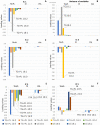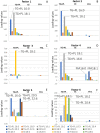Comparison of dimension reduction methods on fatty acids food source study
- PMID: 34548525
- PMCID: PMC8455623
- DOI: 10.1038/s41598-021-97349-6
Comparison of dimension reduction methods on fatty acids food source study
Abstract
Serum fatty acids (FAs) exist in the four lipid fractions of triglycerides (TGs), phospholipids (PLs), cholesteryl esters (CEs) and free fatty acids (FFAs). Total fatty acids (TFAs) indicate the sum of FAs in them. In this study, four statistical analysis methods, which are independent component analysis (ICA), factor analysis, common principal component analysis (CPCA) and principal component analysis (PCA), were conducted to uncover food sources of FAs among the four lipid fractions (CE, FFA, and TG + PL). Among the methods, ICA provided the most suggestive results. To distinguish the animal fat intake from endogenous fatty acids, FFA variables in ICA and factor analysis were studied. ICA provided more distinct suggestions of FA food sources (endogenous, plant oil intake, animal fat intake, and fish oil intake) than factor analysis. Moreover, ICA was discovered as a new approach to distinguish animal FAs from endogenous FAs, which will have an impact on epidemiological studies. In addition, the correlation coefficients between a published dataset of food FA compositions and the loading values obtained in the present ICA study suggested specific foods as serum FA sources. In conclusion, we found that ICA is a useful tool to uncover food sources of serum FAs.
© 2021. The Author(s).
Conflict of interest statement
The authors declare no competing interests.
Figures





References
Publication types
MeSH terms
Substances
LinkOut - more resources
Full Text Sources
Research Materials
Miscellaneous

